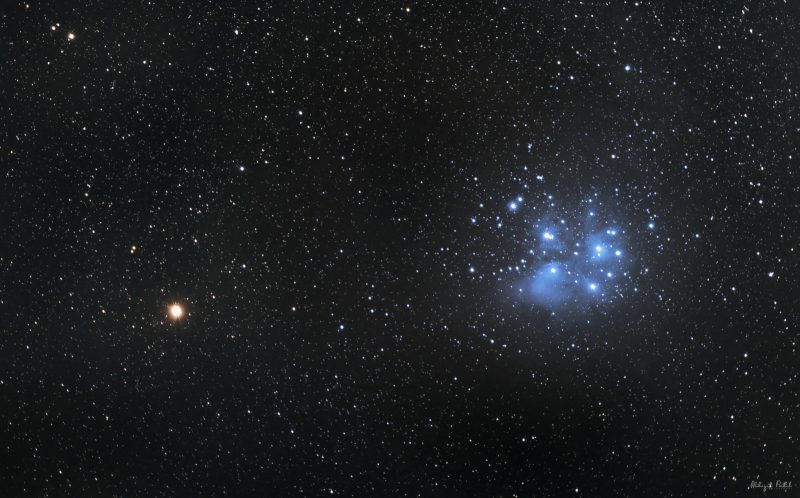On March 3, 2021, the red planet Mars and the famous Pleiades star cluster – also known as the Seven Sisters – stage their closest conjunction on the sky’s dome until 2038. Mars swings 2.6 degrees south of the Pleiades, which appears on our sky’s dome as a tiny, misty dipper of stars. They’ll be a lovely sight in the evening sky, one you can just glance upward to see! One caveat. Don’t mistake Mars for Aldebaran, a bright red star nearby. More about that below.
The whole world will see Mars and the Pleiades close together on this night, and on the nights around it. Their conjunction takes place 2.6 degrees south of the Pleiades cluster on March 3 at 23:26 UTC.
It’ll be the closest Mars-Pleiades conjunction since January 20, 1991, when Mars passed 1.7 degrees south of the Pleiades.
Looking ahead, Mars and the Pleiades won’t be as close again as they are this year until February 4, 2038. Mars will swing 2.0 degrees south of the Pleiades that year.
No matter where you live worldwide, look for Mars and the Pleiades at nightfall and early evening, for that’s when the twosome is highest up for the night. Mars and the Pleiades sink westward as evening deepens into late night, so it might be best to spot the close encounter at early evening. The celestial couple stays out until around midnight at mid-northern latitudes, or mid-evening at temperate latitudes in the Southern Hemisphere.
The Pleiades is easy to recognize with its diminutive size and dipper-like shape. Some people notice it and mistake it for the actual Little Dipper, an asterism in the northern sky. If you’d like confirmation that what you’re seeing really is the Pleiades, look for three medium-bright stars in a short, straight row: the easy-to-spot Belt of Orion, the Hunter. You can star-hop from Orion’s Belt stars – through Aldebaran – to Mars and the Pleiades.
It’s easy to distinguish Mars from Aldebaran, by the way, despite the similarity between the planet and star in color and brightness. That’s because the red “star” appearing much closer to the Pleiades star cluster is none other than Mars.


If you know anything about stars, you know Aldebaran shines by its own light. Meanwhile, Mars shines by reflecting the light of the sun. Aldebaran and the stars of the Pleiades cluster represent “fixed” points of light in the constellation Taurus the Bull. Mars, on the other hand, is a planet in our solar system and therefore much closer to us than the stars. Thus we see Mars move in front of the stars. And so Mars is just a temporary visitor to Taurus, and to the Pleiades.
Do you have binoculars? A typical binocular field spans some 5 degrees of sky, so Mars and the Pleiades cluster should readily fit within a single binocular field for at least several days, if not close to a week. If you’ve never viewed the Pleiades cluster through binoculars, you’re missing out on one of the sky’s most magnificent treasures. Most people can see six Pleiades stars with the eye alone, but binoculars dramatically increase the number of Pleiades stars that you can see.

In early March 2021, Aldebaran might appear a touch brighter than Mars to the eye. Mars is dimming somewhat by the day, and will probably be obviously fainter than Aldebaran by the time Mars passes 7 degrees north of Aldebaran on March 20, 2021. By April 24, 2021, Mars will be fainter yet when it passes out of the constellation Taurus and into the constellation Gemini the Twins.
Mars, the fourth planet from the sun, takes nearly two Earth years to travel full circle through the constellations of the zodiac. Mars normally laps the Pleiades cluster every other year. However, as an exception, Mars’ next conjunction with the Pleiades will happen next year (instead of the year after): August 20, 2022. That’s because this year’s conjunction happens fairly early in the year, and, in addition, no intervening Martian retrograde takes place between the 2021 and 2022 Mars-Pleiades conjunctions. After 2022, Mars-Pleiades conjunctions will happen every other year until March 14, 2036.
Mars-Pleiades conjunctions
March 03, 2021 (Mars 2.6 degrees south of the Pleiades)
August 20, 2022 (Mars 5.4 degrees south of the Pleiades)
July 20, 2024 (Mars 4.7 degrees south of the Pleiades)
June 28, 2026 (Mars 4.4 degrees south of the Pleiades)
June 07, 2028 (Mars 4.1 degrees south of the Pleiades)
May 19, 2030 (Mars 3.7 degrees south of the Pleiades)
April 28, 2032 (Mars 3.6 degrees south of the Pleiades)
April 08, 2034 (Mars 3.3 degrees south of the Pleiades)
March 14, 2036 (Mars 2.9 degrees south of the Pleiades)Source: AstroPixels.com/ Sky Event Almanacs
In rare instances, Mars can have three conjunctions with the Pleiades cluster in period of about 4.7 months. But for this to happen, Mars must reach opposition at a critical time, so that Mars can swing by the Pleiades going in prograde (eastward in front of the background stars of the zodiac), then in retrograde (westward in front of the backdrop stars), and then in prograde (eastward) again. This last happened in 1990-91 and will next happen in in 2037-38.
1990-91:
First conjunction: August 31, 1990 (5.8 degrees, going eastward)
Second conjunction: December 14, 1990 (2.0 degrees, going westward)
Third conjunction: January 20, 1991 (1.7 degrees, going eastward)
Martian opposition: November 27, 1990
2037-38:
First conjunction: September 12, 2037 (6.0 degrees, going eastward)
Second conjunction: November 13, 2037 (3.7 degrees, going westward)
Third conjunction: February 4, 2038 (2.0 degrees, going eastward)
Martian opposition: November 19, 2037
Bottom line: On March 3, 2021, we’ll see the closest Mars-Pleiades conjunction since January 20, 1991. A closer Mars-Pleiades conjunction won’t come again until February 4, 2038.
Still a few 2021 lunar calendars available. Order yours before they’re gone!











